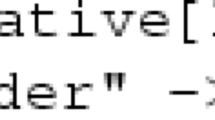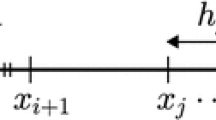Abstract
An American passport option whose contingent claim is dependent on the balance of a trading account can be valued by solving a Hamilton–Jacobi–Bellman equation with free boundary. Here, we present the pricing problem for American passport option, as a sequence of linear complementarity problems, using the three-time level finite difference scheme, which typically is suitable for non-smooth payoffs and also applicable in case of large temporal grid size. The option price is obtained through this scheme for the non-symmetric case (when the risk-free rate is different from the cost of carry). It is observed that the numerical approach presented, results in solving the pricing problem using lesser number of grid points as compared to numerical approaches for this problem used previously while maintaining the accuracy of the prices obtained.

Similar content being viewed by others
References
Andersen L, Andreasen J, Brotherton-Ratcliffe R (1998) The passport option. J Comput Finance 1(3):15–36
Bawa RK, Natesan S (2009) An efficient hybrid numerical scheme for convection-dominated boundary-value problems. Int J Comput Math 86(2):261–273
Borici A, Luthi H (2005) Fast solutions of complementarity formulations in American put pricing. J Comput Finance. https://doi.org/10.21314/JCF.2005.126
Chan SS (1999) The valuation of American passport options. University of Wisconsin-Madison. Working Paper
Cryer CW (1971) The solution of a quadratic programming problem using systematic over relaxation. SIAM J Control 9(3):385–392
Hyer T, Lipton-Lifschitz A, Pugachevsky D (1997) Passport to success. Risk 10(9):127–131
Jaillet P, Lamberton D, Lapeyre B (1990) Variational inequalities and the pricing of American options. Acta Appl Math 21(3):263–289. https://doi.org/10.1007/BF00047211
Kanaujiya A, Chakrabarty SP (2017) Pricing European passport option with radial basis function. Int J Appl Comput Math 3(3):1589–1604
Kanaujiya A, Chakrabarty SP (2017) Pricing and estimates of Greeks for passport option: a three time level approach. J Comput Appl Math 315:49–64
Malloch H, Buchen PW (2010) Passport options: continuous and binomial models. Finance and Corporate Governance Conference 2011 Paper. https://doi.org/10.2139/ssrn.1722392
Merton RC, Brennan MJ, Schwartz ES (1977) The valuation of American put options. J Finance 32(2):449–462
Oksendal B (2003) Stochastic differential equations: an introduction with application. Springer-Verlag, Berlin-Heidelberg
Pooley D (2003) Numerical methods for nonlinear equations in option pricing. Ph.D. Thesis, University of Waterloo
Richtmyer RD, Morton KW (1967) Difference method for initial-value problem. Wiley, New York
Seydel R (2012) Tools for computational finance. Springer, New York
Shaw WT (1998) Modelling financial derivatives with Mathematica. Cambridge University Press, Cambridge
Smith GD (1985) Numerical solution of partial differential equations: finite difference methods. Oxford University Press, Oxford
Topper J (2003) A finite element implementation of passport options. M.Sc. Thesis, University of Oxford
Acknowledgements
The first author is grateful to Indian Institute of Technology Guwahati for the financial support provided to pursue his Ph.D. The authors express their gratitude to the Editor and both the reviewers for the suggestions which resulted in an improved manuscript.
Author information
Authors and Affiliations
Corresponding author
Additional information
Communicated by Jorge Zubelli.
Publisher's Note
Springer Nature remains neutral with regard to jurisdictional claims in published maps and institutional affiliations.
Rights and permissions
About this article
Cite this article
Kanaujiya, A., Chakrabarty, S.P. Valuation of American passport option using a three-time level scheme. Comp. Appl. Math. 38, 30 (2019). https://doi.org/10.1007/s40314-019-0785-9
Received:
Revised:
Accepted:
Published:
DOI: https://doi.org/10.1007/s40314-019-0785-9




